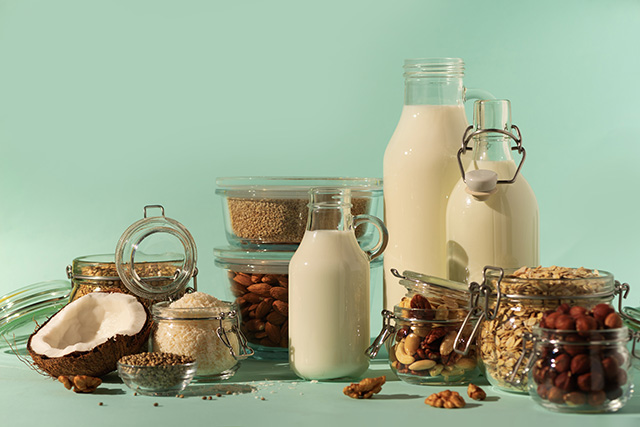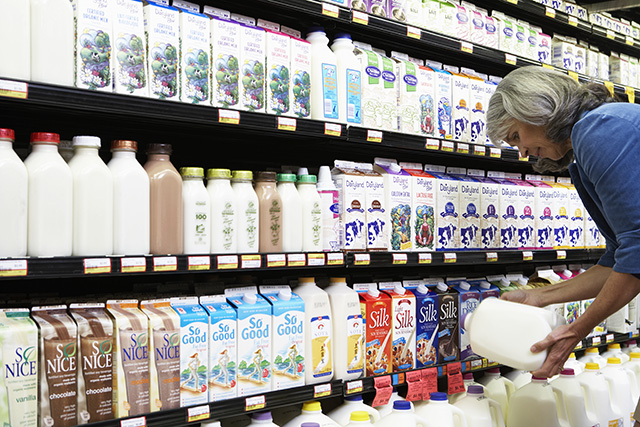Whether you’re looking to cut out dairy milk completely or supplement with plant-based milk to reduce calories, avoid allergens or be more green, there’s a nondairy milk option to suit your needs.
Check out this guide to the world of plant-based dairy alternatives.
Why Go for Plant-Based?
People are choosing to drink less – or completely cut out – cow’s milk for a variety of reasons, including allergies, dietary restrictions, intolerance, personal preference or ethical concerns.
Breaking Down Dairy Milk
Traditional dairy milk was once an American staple, but consumers have been buying less and less of it over the years.
“Weekly average purchases of cow’s milk declined 12% from about 0.41 gallon per household per week in 2013 to 0.36 gallon per household per week in 2017,” according to the USDA. “By contrast, purchases of almond, soy and other plant-based products increased 36% from 0.028 gallon to 0.038 gallon per household per week.”
Dairy milk is a good source of calcium, vitamin D and vitamin B12. One cup of cow’s milk also has about 12 grams of carbs, 2 to 8 grams of fat – depending on whether it’s whole milk, 1%, 2% or skim – and 8 grams of protein.
However, drinking too much cow’s may have adverse effects on the body.
Milk and other dairy products are the top source of saturated fat in the American diet, according to the Physicians Committee for Responsible Medicine. Studies have also linked dairy to an increased risk of breast, ovarian and prostate cancers.
Additional Health Reasons
People are giving up dairy milk for a variety of health-related reasons. One of the biggest is intolerance.
65% of the global population has some degree of lactose intolerance in adulthood, according to the U.S. National Library of Medicine. Ingesting dairy milk when you have an intolerance can lead to symptoms like abdominal bloating, cramps and pain, nausea, gas and diarrhea.
Another reason is public perception that plant-based milks are a healthier alternative to cow’s milks, since most plant-based milks have fewer carbs and less fat compared to dairy milk. Some people also want to avoid the antibiotics and hormones associated with some cow’s milk.
Environmental Concerns
An additional cause for the rise in nondairy milk options are environmental concerns. Many consumers are looking for products that require the least amount of resources to make – think water and land use – while producing less waste/pollution.
Cows produce a lot of methane. “Methane from livestock is the second largest source of methane emissions in the U.S., and dairy cattle alone accounted for 26% of total enteric emissions,” according to the U.S. Department of Agriculture.
Raising cows also takes a lot of space – 1.5 miles to make just one cup of cow’s milk. Growing almonds, oats and soybeans only takes about 0.09 square miles per glass.
Dairy milk also uses a considerable amount of water, 30-plus gallons per glass, compared 18 gallons for almond milk. Soy and oat milks require even less water to grow – only 1 to 3 gallons per cup.

Which Nondairy Milk Option Is Right for You?
You should decide on a nondairy milk by reading the nutrition facts and making sure the milk fits your needs. Many plant-based milks are fortified with vitamins and minerals they’re otherwise missing – like calcium – providing anywhere from 10% to 45% of your daily value.
Nutritional value and calories vary by type and brand of milk. Do your research and compare products. Finally, conduct a taste test to find your perfect glass of plant-based milk. Or try making plant-based milk at home to avoid preservatives and control sugar and salt levels.
Types of Plant Milk
Almond Milk
There are a variety of nutty, milk-like beverages to choose from – including those made from almonds, cashews, hazelnuts, macadamia nuts, peanuts and walnuts – though almond milk is currently one of the most popular.
One cup of unsweetened almond milk contains about 30 to 50 calories, 2.5 grams of fat, 1 gram of protein and 1 to 2 grams of carbohydrates, according to Healthline.
Pros: low-calorie, low-carb, good source of vitamin E
Cons: low-protein, environmental impact (water)
Other Nut Milks
If you’re looking for a nut milk with a bit more sustenance, peanut milk has more protein than almond milk – 6 grams per cup – followed by hazelnut and walnut milk, which each have 3 grams. However, peanut milk has more calories (about 150) and fat (11 grams) and little additional nutritional value, while walnuts boast omega-3s and hazelnuts have vitamin B and E.
On the other end of the spectrum, there are lower-calorie options like cashew (25 calories) and macadamia nut milks (50-70 calories). These also have a gram or less of protein and carbs and between 2 and 5 grams of fat – but you’ll also find some calcium and vitamin D.
*Nut milks should not be consumed by anyone with a nut allergy.
Coconut Milk
Despite its name, coconut is actually a fruit, making this milk a safe option for those with nut allergies. Coconut milk can be thick or thin and come in a can or a carton.
Nutritional value depends on how much water is added. Traditional, undiluted coconut milk is high in calories – mostly from fat – and a good source of vitamins and minerals like copper, iron and manganese. One cup of the thinner, more drinkable coconut milk provides about 45 calories, 4 grams of fat and little to no carbs or protein, according to Healthline.
Pros: low-calorie, low-carb (for thinned milk), relatively low water and land use
Cons: low-protein, higher in saturated fats, environmental impact (transportation)
Soy Milk
If you’re looking for the closest thing to dairy milk in terms of nutrition, soy milk is a good choice. Soy milk has all nine amino acids and as much protein as cow’s milk. It’s also a good source of potassium.
One cup of unsweetened soy milk contains 80 to 90 calories, 4 to 4.5 grams of fat, 7 to 9 grams of protein and 4 grams of carbs, according to Healthline.
Pros: complete protein, potassium, relatively low emissions and water usage
Cons: more fat, environmental impact (deforestation)
Oat Milk
Oat milk has beta-glucan, a type of soluble fiber that plays a “beneficial role in insulin resistance, dyslipidemia, hypertension and obesity,” according to the U.S. National Library of Medicine.
One cup of oat milk contains 140 to 170 calories, 4.5 to 5 grams of fat, 2.5 to 5 grams of protein and 19 to 29 grams of carbohydrates, according to Healthline.
Pros: second most protein after soy milk, little water and land use, low emissions
Cons: higher calorie, more fat
*If you have celiac disease or are gluten-intolerant, make sure your oat milk is certified gluten-free, as not all varieties are.
Rice Milk
Rice milk is the least allergenic nondairy milk, according to Healthline, making it an option for those with an intolerance to dairy, gluten, soy and/or nuts. However, it’s also the highest in carbohydrates and can raise blood sugar quickly.
“Rice milk has also been shown to contain high levels of inorganic arsenic, a toxic chemical found naturally in the environment,” according to Healthline.
One cup of rice milk contains 130 to 140 calories, 2 to 3 grams of fat, 1 gram of protein and 27 to 38 grams of carbohydrates, according to Healthline.
Pros: least allergenic, low-fat
Cons: arsenic, high-carb, low-protein, environment impact (water)
*Drinking too much rice milk is not advised, especially for young children and pregnant women.
Making a Decision
The secret to eating healthy is making sure your diet is well-balanced. If you choose to switch to dairy-free milk options entirely, consider eating plenty of leafy greens and other vegetables that contain calcium, vitamins and other nutrients your body needs.
There’s also no rule limiting you to just one type of nondairy milk. As long as you’re avoiding allergens, try switching up your plant-based milks from time to time to get a variety of nutritional benefits. Also, go for organic products to avoid pesticides and herbicides – a healthier and more environmentally-friendly choice.
Looking for more content like this? Check out our guide to plant-based meat alternatives.
What’s your favorite nondairy milk option? Tell us in the comments.
One Thought on “Got (Plant-Based) Milk? A Guide to Nondairy Milk Options”
Leave A Comment
Comments are subject to moderation and may or may not be published at the editor’s discretion. Only comments that are relevant to the article and add value to the Your AAA community will be considered. Comments may be edited for clarity and length.




















Flax milk is the best I’ve tried. The one I drink is fortified with vitamins like calcium and B12, plus there’s added protein and low calorie.